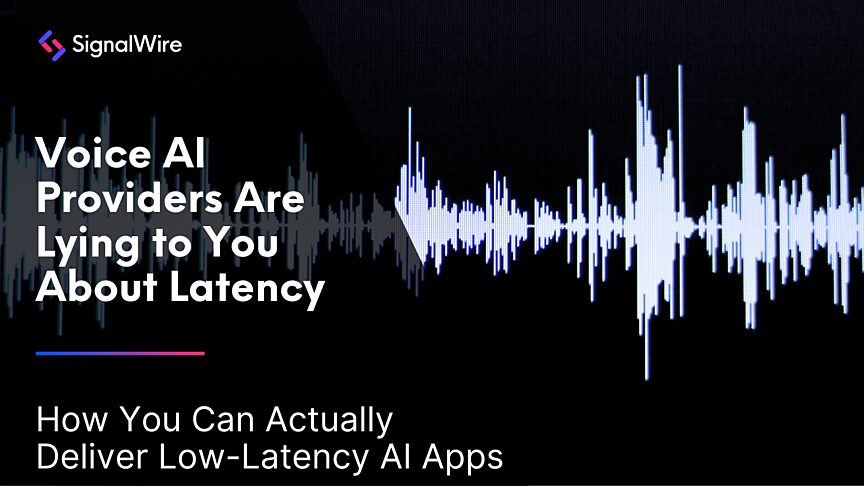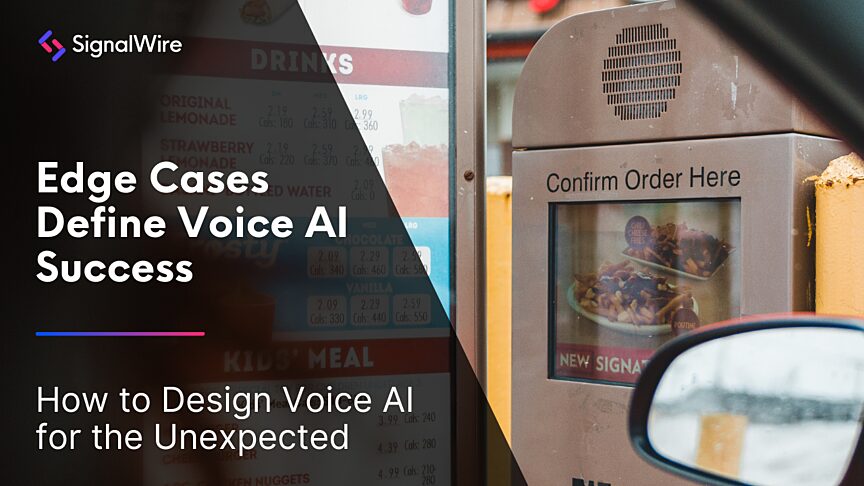Why every millisecond matters when you build a “human-like” voice agent
When your voice system speaks to a user, the split second between “user finishes speaking” and “system begins responding” is the moment that makes or breaks the illusion of a real conversation. That split-second is latency.
In the domain of voice AI, latency is not a side-feature you optimize later. It’s the foundation of the conversational customer experience and the difference between business success or failure. For voice AI built for customer service, contact centers, or high-volume self-service, latency is a massive competitive differentiator.
For developers who are building real-time voice agents, this means latency must be front and center in your planning, design, selection, deployment, and monitoring. In this post, we’ll go over what latency is in voice AI, where it comes from, what acceptable thresholds look like, and how to reduce it.
What is latency in Voice AI?
Broadly, latency is the time delay between the initiation of a task and its completion. In voice AI, this is typically defined as the end-to-end audio round trip: when the user stops speaking (or the system detects the utterance), to when the user begins hearing the system’s response. Breaking it down in a voice context:
The user speaks; their voice is captured and streamed or sent to processing.
The system performs automatic speech recognition (ASR) to convert audio to text.
Natural language understanding (NLU) or LLM logic interprets intent, context, maybe queries databases with a retrieval-augmented generation (RAG) API, and applies business logic.
Text-to-Speech (TTS) generates audio output.
Audio is sent back to the user and played.
Any telephony or media layers (SIP, codec, network hops) add additional delay.
Each of those steps adds milliseconds, and the sum is what users feel.
Types of latency
Network latency: Time for packets to travel between user device/browser/phone to the backend or cloud and back.
Compute/processing latency: Time for ASR, NLU, TTS, model inference, etc. to finish.
Media/telephony latency: Codec buffering, transcoding, SIP hops, carrier delays.
Pipeline/architectural latency: Sequential dependencies (waiting for one step to finish before starting next) add additional delay.
Unfortunately, it can be difficult to know which part of the latency chain AI voice providers are measuring. But if someone is saying their AI voice agent’s latency is 100ms or less, they are claiming the impossible by only reporting one part of the latency pipeline.
UX impact of latency
A voice agent with noticeable "dead air" feels unnatural. Latency between 500-1000ms keeps things smooth; beyond ~2000ms, conversations start to fail.
Business impact of latency
Users abandon or interrupt voice sessions when responses lag, and this increases abandonment rate, escalation rate (to humans), and drops containment (automated completion).
Brand perception suffers. If a voice-agent feels sluggish, the interaction reflects on the overall brand quality.
Operational cost increases. Longer interactions and more pauses mean more agent cost, more backend resource consumption.
If your voice agent feels slow while a competitor’s feels real-time, you lose.
Architectural and scale implications
At enterprise scale, latency is at the heart of the user experience, and systems should be designed with latency as a first-class concern. If you build using generic cloud services with multiple hops, you’ll pay the latency tax.
What is “good” latency for voice AI?
Benchmarks vary hugely by use case, geography, network conditions, and hardware. That said, here are some general guidelines:
<200 ms: Not currently possible for generative voice AI. Voice AI providers claiming numbers like this are being deceptive.
500-1000 ms: Acceptable in most use cases.
>1000 ms: Degradation starts to show; conversation flow may feel off.
Users may notice, interrupt, or abandon.>2000 ms: unacceptable for live voice interaction; feel “broken”.
At SignalWire, we’ve studied how latency makes users feel during conversations:
Our findings are that roundtrip voice AI latency under 1000ms generally ensures smooth, natural conversations.
Common causes of latency in voice AI
Understanding where latency accumulates is critical if you want to reduce it. Here are key culprits:
1. Network and geographic distance
Whenever audio has to travel from user device to remote cloud region (or across carrier hops) and back, each physical/virtual hop adds delay. If your service is globally deployed but localized to one region, callers far away will feel higher latency.
2. Legacy telephony/media infrastructure
Carrier networks, PBXs, SIP gateways, codec transcoding all add buffering and delay. Telephony-specific delays often exceed what the AI stack itself introduces. This is why AI directly in the telecom stack is such a big deal.
3. Sequential processing pipelines
If your pipeline follows this sequence:
wait for full utterance → send to ASR → wait → send to NLU → wait → send to TTS → wait → playback
then you’re stacking delays.
4. Buffering and codec issues
Many voice media systems buffer audio (to ensure stability) or use codecs that introduce delay (for compression, packetization). These are often overlooked.
5. Lack of measurement/monitoring
If you don’t track latency across your stack, you won’t know where the delay is or whether optimizations work.
How do you reduce latency in Voice AI?
Here’s a developer-friendly toolbox of techniques that you can apply when building or selecting a voice AI platform.
Use streaming and parallel-processing pipelines
Instead of waiting for full utterance, use streaming ASR (partial transcripts while the user is speaking) and begin processing NLU/TTS while ASR continues. This is a method SignalWire uses to reduce latency called transparent barge.
Deploy closer to the user (edge/regional deployments)
Reduce network latency by locating processing in data-centres or edge PoPs near your users. Use carrier edge or regional pods to shorten distance.
Collapse the pipeline (co-locate services)
Keep ASR → NLU → TTS in the same region,same server, or even same provider, and favor persistent connections (WebSockets) vs multiple REST hops. Reduce external API call overhead by choosing a provider that keeps AI in the telecom stack.
Optimize models
Use specialised models where possible rather than general-purpose heavyweight ones. Techniques like quantisation (reducing bits) and pruning remove unnecessary compute overhead.
Minimize media overhead
Choose codecs and media paths designed for real-time (low-latency codecs, minimal buffering). Avoid unnecessary transcoding or extra SIP hops. Shorten the media path as much as possible.
Instrument latency at all layers and optimise iteratively
Track key metrics: time from when user stops speaking to agent reply start (end-to-end latency), ASR latency, NLU latency, TTS latency, network hops. Iterate frequently. Even small latency gains dramatically improve perceived responsiveness and conversational flow.
Developer checklist for faster voice AI agents
If you’re building a voice AI agent using SignalWire AI Voice Agents (or any similar platform), here are key questions to ask:
What is the end-to-end latency for a typical user path (user → voice agent reply)?
Where are the bottlenecks? (network, ASR, model inference, TTS, media)
Does your system support streaming ASR/TTS and parallel processing?
Can you deploy nearer to users (regional or edge endpoints)?
Are you using models tuned for low latency?
What fallback or mitigation strategies exist for high-latency circumstances?
Latency is the invisible metric that either makes a voice AI feel effortlessly human or painfully robotic. For developers building voice AI agents, latency must be a design principle, a monitored KPI, and a fundamental part of your value proposition.
When you apply the strategies above by partnering with the right voice AI provider, you’ll build systems that become your competitive edge.
To try out SignalWire AI, sign up for a free account, and bring your questions to our community on Discord.
Voice AI frequently asked questions
What is an acceptable latency target for voice AI?
While it depends on use case, many voice-AI systems aim for between 500-1000ms end-to-end to feel human-like. Above 1000ms starts to degrade experience.
Which part of the pipeline usually adds the most latency?
It varies, but often the network/media path and the model inference (ASR/LLM) are the largest contributors. Without proximity and streaming support, network delay can dominate.
Can you optimize latency after product launch?
Yes, but you’re better off designing for low latency from the start. Optimising later may require major architectural changes rather than tweaks.
How do AI vendors measure latency?
Different vendors measure different parts of the chain. Some measure only ASR speed or only TTS speed, which is not the true end-to-end conversational delay. True latency must include every step.
What is the end-to-end latency for phone calls with AI agents?
Telephony paths typically add 200–500 ms of unavoidable delay from SIP routing, carrier hops, jitter buffering, and codecs. This sits on top of AI processing time, making sub-500 ms conversational latency extremely difficult to achieve. This is why working with providers who have AI built into the telecom stack makes things faster.
Is 100ms latency possible in Voice AI?
No, not for full conversational pipelines. Sub-100-ms numbers typically refer to one part of the pipeline. True end-to-end voice latency below 500ms is extremely rare in the real world.


